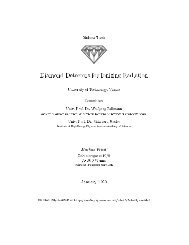You also want an ePaper? Increase the reach of your titles
YUMPU automatically turns print PDFs into web optimized ePapers that Google loves.
which covers the rapidity range of |η| > 8 (equivalent to deflection angles < 400 µrad).Projected use cases include triggering for diffractive and heavy ion physics as well asbeam optics measurements.3.2.7 SolenoidThe CMS solenoid provides a magnetic field parallel to the beam axis with an inductionof B = 4 T at the interaction point. This high magnetic field is required to provideenough bending power to achieve the requirements for the muon momentum resolution.The conductor consists of 4 layers of superconducting NbTi cabling directly bondedwith aluminium alloy to achieve the necessary structural stability. To maintain thesuperconducting state, the 220 t cold mass must be enclosed in a stainless steel vacuumtank and kept below its critical temperature using liquid helium cooling. The nominaloperating current is 19.1 kA.The magnetic flux from the solenoid is returned on the outside through a 1.5 mthick steel yoke that also contains the CMS muon system and is completely saturatedat nominal conditions. The yoke consists of 11 elements (6 endcap disks and 5 barrelwheels) that can be moved separately. The central barrel wheel holds the magnet coiland the cryostat. At 10,000 t, this yoke contains almost half of the total mass of CMS.3.2.8 Muon SystemThe detection of muons is of central importance to CMS because several expecteddiscovery channels have final states including muons. The mass resolution attainablefor muons is superior to that of other leptonic final states because they are much lessaffected by material interactions in the tracker. The three main tasks of the muonsystem are identification of muons, measuring of the muon momentum and triggering.In the barrel, the mainstay of the muon system is formed by drift tubes, whichare simply gas-based ionization detectors segmented into tubes for reliability reasons.However, since drift tubes suffer from comparatively slow response, the drift tubesare augmented by resistive plate chamber detectors, which provide better time resolutionand thus more reliable bunch crossing identification, but with coarser positionresolution.In the endcaps, a different system is needed because of the higher magnetic field,higher muon rate and greater background. Here, the principal detectors are cathodestrip chambers, which measure charges induces on strip cathodes by nearby ionizationavalanches.Drift TubesThe basic drift tube cell consists of an anode wire with a length of 2−3 m, surroundedby a 42 × 13 mm tube whose surface contains several cathodes, optimized to attainlinear position response over the entire cell volume. The tube is filled with a mixtureof about 85% Ar and 15% CO 2 . A number of identically oriented cells are organizedinto layers, which are in turn accumulated into superlayers consisting of four layers28












